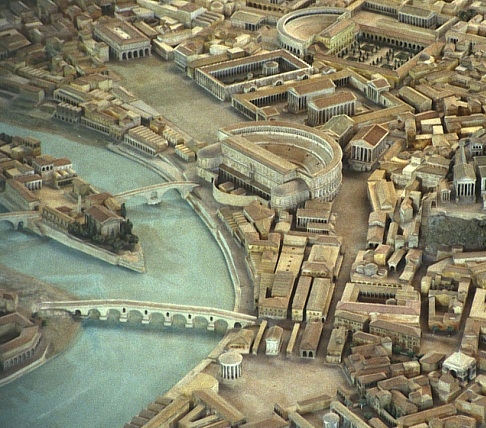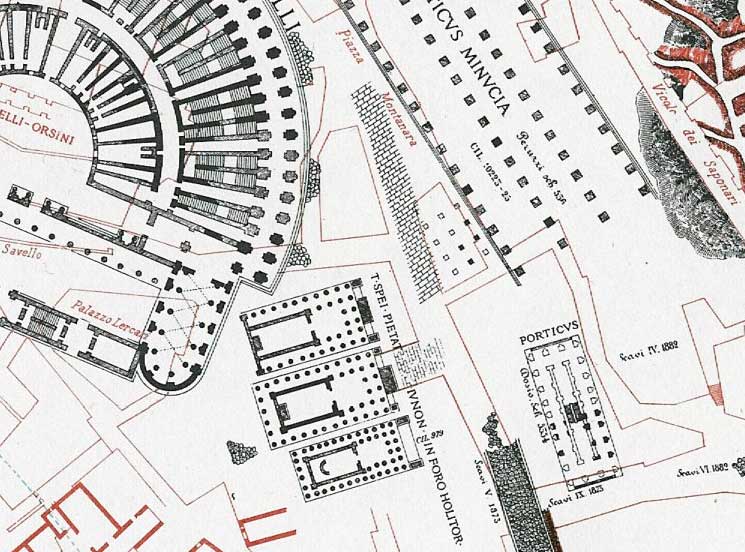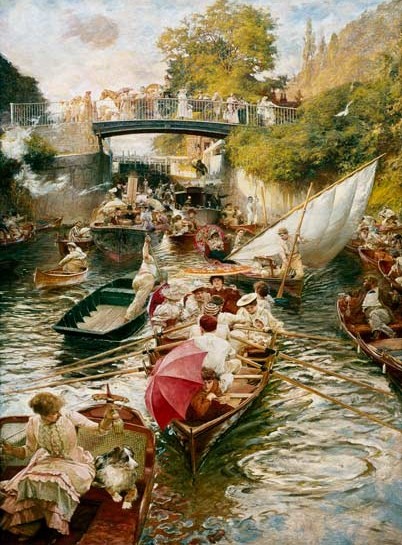|
Gaius Duilius
Gaius Duilius ( 260–231 BC) was a Roman general and statesman. As consul in 260 BC, during the First Punic War, he won Rome's first ever victory at sea by defeating the Carthaginians at the Battle of Mylae. He later served as censor in 258, and was appointed dictator to hold elections in 231, but never held another command. Background Gaius Duilius, whose father and grandfather were both named Marcus Duilius, belonged to a undistinguished family. One Caeso Duilius is recorded as consul in 336 BC, but the surname is otherwise only known historically and reliably from a few minor magistrates in the fourth century BC. Career Naval victory Duilius was one of the consuls for the year 260 BC, and was initially appointed to command Rome's land forces in Sicily against Carthage, as part of the First Punic War. His colleague in office, Gnaeus Cornelius Scipio, held charge of the fleet. The Romans built 120 warships and despatched them to Sicily in 260 BC for their crews to carry ... [...More Info...] [...Related Items...] OR: [Wikipedia] [Google] [Baidu] |
Roman Dictator
A Roman dictator was an extraordinary magistrate in the Roman Republic endowed with full authority to resolve some specific problem to which he had been assigned. He received the full powers of the state, subordinating the other magistrates, consuls included, for the specific purpose of resolving that issue, and that issue only, and then dispensing with those powers forthwith. Dictators were still controlled and accountable during their terms in office: the Senate still exercised some oversight authority and the right of plebeian tribunes to veto his actions or of the people to appeal from them was retained. The extent of a dictator's mandate strictly controlled the ends to which his powers could be directed. Dictators were also liable to prosecution after their terms completed. Dictators were frequently appointed from the earliest period of the Republic down to the Second Punic War (218–201 BC), but the magistracy then went into abeyance for over a century. It was late ... [...More Info...] [...Related Items...] OR: [Wikipedia] [Google] [Baidu] |
Military Tribune
A military tribune (Latin ''tribunus militum'', "tribune of the soldiers") was an officer of the Roman army who ranked below the legate and above the centurion. Young men of Equestrian rank often served as military tribune as a stepping stone to the Senate. The ''tribunus militum'' should not be confused with the elected political office of tribune of the people ''(tribunus plebis)'' nor with that of '' tribunus militum consulari potestate''. Early Rome The word ''tribunus'' derives from '' tribus'', "tribe". In Rome's earliest history, each of the three tribes (Ramnes, Luceres, and Tities) sent one commander when an army was mustered, since there was no standing army. The tribunes were commanders of the original legion of 3,000. By the time of the Greek historian Polybius (d. 118 BC), the tribunes numbered six, and they were appointed by the consuls. However, the process by which tribunes were chosen and assigned is complex and varies at different times. Republican period ... [...More Info...] [...Related Items...] OR: [Wikipedia] [Google] [Baidu] |
Forum Holitorium
The Forum Holitorium ( it, Foro Olitorio; en, Vegetable-sellers' Market) is an archaeological area of Rome, Italy, on the slopes of the Capitoline Hill. It was "oddly located" outside the Porta Carmentalis in the Campus Martius, crowded between the Forum Boarium ("Cattle Market") and buildings located in the Circus Flaminius. In ancient times it was the fruit and vegetable market, while the area of the adjacent Forum Boarium served as meat market. It also included a sacred area with three small temples dedicated to Janus, Spes and Juno Sospita. The sacred area The construction of the sacred area of the forum dates back to the Republican age, more precisely to the period between the first and the second Punic War. Subsequently, at the time of Caesar ( 1st century BC), it underwent renovations which involved the demolition of a fourth temple: it was built by Manius Acilius Glabrio (consul in 191 BC) next to the Temple of Janus and was demolished during the construction of the ... [...More Info...] [...Related Items...] OR: [Wikipedia] [Google] [Baidu] |
Temple Of Janus (Forum Holitorium)
The Temple of Janus at the Forum Holitorium is the second known temple dedicated to Janus, besides the temple of the same name located in the Roman Forum. It is known that it stood "close to the Theatre of Marcellus" (''ad theatrum Marcelli'' or ''iuxta theatrum Marcelli'') and "outside Porta Carmentalis" (''extra portam Carmentalem'') and that feasts took place there in August and October. It is highly likely that it is one of the three contiguous temples from the Republican era in the area of the ancient Forum Holitorium – where now stands the church of S. Nicola in Carcere – and more specifically the northernmost one, to the right than the facade of the church. The remains of the temple are seven columns in tuff - a material typical of the original age of construction and of the Roman tradition - incorporated with their architrave in the right side of the church and two columns rising on the basement just near the Theatre of Marcellus. History The temple was built b ... [...More Info...] [...Related Items...] OR: [Wikipedia] [Google] [Baidu] |
Camporeale
Camporeale ( Sicilian: ''Campuriali'') is a ''comune'' (municipality) in the Metropolitan City of Palermo in the Italian region Sicily, located about southwest of Palermo. As of 31 December 2004, it had a population of 3,652 and an area of .All demographics and other statistics: Italian statistical institute Istat. Camporeale borders the following municipalities: Alcamo, Monreale Monreale (; ; Sicilian: ''Murriali'') is a town and ''comune'' in the Metropolitan City of Palermo, in Sicily, southern Italy. It is located on the slope of Monte Caputo, overlooking the very fertile valley called ''"La Conca d'oro"'' (the Gold .... Demographic evolution Colors= id:lightgrey value:gray(0.9) id:darkgrey value:gray(0.8) id:sfondo value:rgb(1,1,1) id:barra value:rgb(0.6,0.7,0.8) ImageSize = width:455 height:303 PlotArea = left:50 bottom:50 top:30 right:30 DateFormat = x.y Period = from:0 till:7000 TimeAxis = orientation:vertical AlignBars = justify ScaleMajor ... [...More Info...] [...Related Items...] OR: [Wikipedia] [Google] [Baidu] |
Termini Imerese
Termini Imerese (; scn, Tèrmini ) , grc, Θερμαὶ αἱ Ἱμερᾶαι , grc, Θερμαὶ Ἱμέραι , or grc, Θερμὰ (Ἱμεραῖα) ; la, Thermae Himerenses; literally " Himera's hot springs". is a town of the Metropolitan City of Palermo on the northern coast of Sicily, in Italy. It is one of the most important towns of the Metropolitan City of Palermo, from which it is 33 km far. The town is easily reachable through its well developed infrastructures: there are three highway exits along the A19, its station is the meeting point between all of the Sicilian railway lines and its seaport links the town with other important maritime Italian cities. It has a judicial district. It's culturally interesting for the close Greek ruins of Himera, its numerous churches, Roman ruins, prehistorical finds and the annual celebration of the Carnival, one of the oldest of Italy. In the heart of the old town, at its lower level, there are the thermal baths of th ... [...More Info...] [...Related Items...] OR: [Wikipedia] [Google] [Baidu] |
Segesta
Segesta ( grc-gre, Ἔγεστα, ''Egesta'', or , ''Ségesta'', or , ''Aígesta''; scn, Siggésta) was one of the major cities of the Elymians, one of the three indigenous peoples of Sicily. The other major cities of the Elymians were Eryx and Entella. It is located in the northwestern part of Sicily in Italy, near the modern commune of Calatafimi-Segesta in the province of Trapani. The hellenization of Segesta happened very early and had a profound effect on its people. History Origins The origin and foundation of Segesta are extremely obscure. The tradition current among the Greeks and adopted by Thucydides, ascribed its foundation to a band of Trojan settlers, fugitives from the destruction of their city; and this tradition was readily welcomed by the Romans, who in consequence claimed a kindred origin with the Segestans. Thucydides seems to have considered the Elymians ( la, Elymi), a barbarian tribe in the neighborhood of Eryx and Segesta, as descended from the Trojans ... [...More Info...] [...Related Items...] OR: [Wikipedia] [Google] [Baidu] |
Polybius
Polybius (; grc-gre, Πολύβιος, ; ) was a Greek historian of the Hellenistic period. He is noted for his work , which covered the period of 264–146 BC and the Punic Wars in detail. Polybius is important for his analysis of the mixed constitution or the separation of powers in government, his in-depth discussion of checks and balances to limit power, and his introduction of "the people", which influenced Montesquieu's '' The Spirit of the Laws'', John Locke's ''Two Treatises of Government'', and the framers of the United States Constitution. The leading expert on Polybius for nearly a century was F. W. Walbank (1909–2008), who published studies related to him for 50 years, including a long commentary of his ''Histories'' and a biography. Early life Polybius was born around 200 BC in Megalopolis, Arcadia, when it was an active member of the Achaean League. The town was revived, along with other Achaean states, a century before he was born. Polybius' father, L ... [...More Info...] [...Related Items...] OR: [Wikipedia] [Google] [Baidu] |
Skiff
A skiff is any of a variety of essentially unrelated styles of small boats. Traditionally, these are coastal craft or river craft used for leisure, as a utility craft, and for fishing, and have a one-person or small crew. Sailing skiffs have developed into high performance competitive classes. Many of today's skiff classes are based in Australia and New Zealand in the form of , , and skiffs. The 29er, 49er, SKUD and Musto Skiff are all considered to have developed from the skiff concept, all of which are sailed internationally. The term skiff is also used for a racing shell called single scull for competitive rowing. Etymology The word is related to ''ship'' and has a complicated etymology: "skiff" comes from the Middle English ''skif'', which derives from the Old French ''esquif'', which in turn derives from the Old Italian ''schifo'', which is itself of Germanic origin (German ''Schiff''). "Ship" comes from the Old English "scip", which has the same Germanic predec ... [...More Info...] [...Related Items...] OR: [Wikipedia] [Google] [Baidu] |
Mylae
Milazzo (Sicilian language, Sicilian: ''Milazzu''; la, Mylae; ) is a town (''comune'') in the Metropolitan City of Messina, Sicily, southern Italy; it is the largest commune in the Metropolitan City after Messina and Barcellona Pozzo di Gotto. The town has a population of around 31,500 inhabitants. History Several civilizations settled in Milazzo and left signs of their presence from the Neolithic age. In Homer's ''Odyssey'' Milazzo is presumably the place where Ulysses is shipwrecked and meets Polyphemus. Historically, the town originated as the ancient ''Mylae'' ( grc, Μύλαι), an outpost of Zancle, occupied before 648 BC, perhaps as early as 716 BC. It was taken by the Athenians in 426 BC. The people of Reggio Calabria, Rhegium planted the exiles from Naxos and Catana in 395 BC as a counterpoise to Dionysius the Elder's foundation of Tyndaris; but Dionysius soon took it. In the bay Gaius Duilius won battle of Mylae, the first Roman naval victory over the Carthage, Cart ... [...More Info...] [...Related Items...] OR: [Wikipedia] [Google] [Baidu] |
Ramming
In warfare, ramming is a technique used in air, sea, and land combat. The term originated from battering ram, a siege weapon used to bring down fortifications by hitting it with the force of the ram's momentum, and ultimately from male sheep. Thus, in warfare, ramming refers to hitting a target by running oneself into the target. Today, hand-held battering rams are one tool among many used by law enforcement and military personnel for door breaching. Forcible entry by criminals has been implemented using such methods as vehicles rammed into buildings. Naval warfare Navies in antiquity commonly used the ram: the "beak" ( la , rostrum) became an important part of the armament of the galleys of Imperial Rome. The ancient Greeks used their trireme vessels for ramming as well. In ancient China, rams were largely unknown, as the lack of a keel and the flat shape of the junk's bow was not conducive to constructing an elongated underwater spur. The first recorded use of a ram in ... [...More Info...] [...Related Items...] OR: [Wikipedia] [Google] [Baidu] |
Naval Tactics In The Age Of Galleys
Galley tactics were the dominant form of naval tactics used from antiquity to the late 16th century when sailing ships began to replace oared ships as the principal form of warships. Throughout antiquity and the Middle Ages until the 16th century, the weapons relied on were the ship itself, used as a battering ram or to sink the opponent with naval rams, the mêlée weapons of the crew, missile weapons such as bolts from heavy crossbows fixed on the bulwarks, bows and arrows, weights dropped from a yard or pole rigged out, and the various means of setting an enemy alight. The latter could be done by shooting arrows with burning tow or by Greek fire ejected through specially designed siphons. All galley actions were fought at close quarters, where ramming and boarding were possible. But the use of the ram was only available for a vessel driven by oars. While fleets depended on the methods of battle at close quarters, two conditions were imposed on the warship: light structure, ... [...More Info...] [...Related Items...] OR: [Wikipedia] [Google] [Baidu] |






